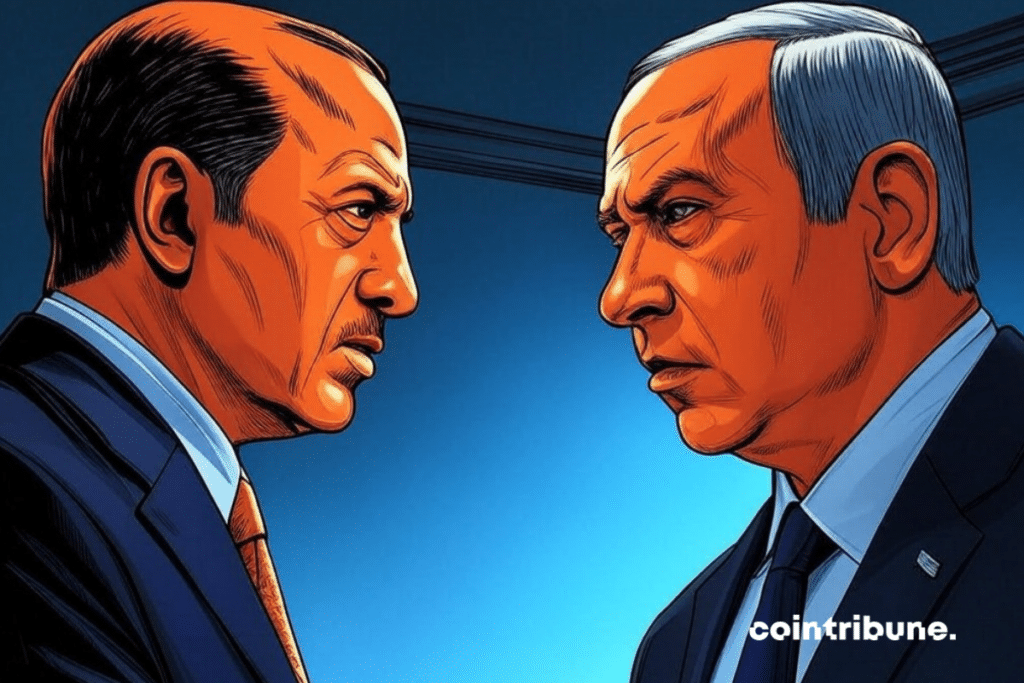The Upcoming War Between Turkey And Israel
The Middle East is currently undergoing a profound reconfiguration of its alliances and historical rivalries. The gradual collapse of the Syrian regime and the weakening of Iran are reshuffling the cards in an already unstable region. This new dynamic is bringing Turkey to the forefront as a regional expansionist power, potentially pushing Israel and some Arab countries towards an unprecedented alliance.

The Return of Turkish Ambitions in the Middle East
Erdogan’s Turkey is reconnecting with its historical ambitions in the former Ottoman space, particularly in Syria and Iraq. The recent fall of the Syrian regime has accelerated this dynamic.
This resurgence is not insignificant: it is part of a historical continuum where Mesopotamia and Syria have always been friction zones between Turkish and Persian powers. The ancient Ottoman and Persian borders are becoming lines of friction, just as they were under the Roman Empire facing the Sassanids.
This expansion is primarily expressed through economics. Turkey has become Iraq’s largest trading partner, surpassing Iran, marking a significant shift in the region. Economic influence generally precedes political influence, and Ankara is methodically consolidating its position in these territories it considers its natural sphere of influence.
The sevenfold increase in the Turkish population since its national revolution has created an exceptional demographic dynamic, transforming Turkey into a leading regional power. With its 84 million inhabitants, it can now compete with Iran. Moreover, its growing control over Syria, through support for al-shaara, allows it to extend its influence without direct intervention. This strategy aims to create a buffer zone that could eventually expand towards Sunni Iraq.
Iran on the Brink of Regime Change
The Islamic Republic of Iran finds itself in a precarious situation, corresponding to an end of the Ancien Régime from a historical perspective. The end of the mullah regime in Iran could accelerate regional reconfiguration and provide new opportunities for Turkish expansionism. Iran is, in reality, one major military defeat away from the collapse of its regime.
Iran has already suffered significant setbacks through its proxies in Lebanon and Syria. Its influence in Iraq, which constituted a protective “glacis” against the West, is now threatened by Turkish advances. The loss of this vassal territory would represent a decisive shift in the regional balance, especially as the populations of northwestern Iran, of Azerbaijani and Turkophone origin, could be exploited by Ankara.
The recent tensions between Tehran and Ankara illustrate this growing rivalry. The Turkish Foreign Minister, Hakan Fidan, warned that “those who live in glass houses should avoid throwing stones,” in response to Iranian criticisms regarding Turkey’s policy in Syria. These exchanges, unusual between these two powers, testify to a deterioration of their relations.
Israel and Its Regional Normalization in the Middle East
Israel is also experiencing a significant evolution in its regional position. Since the Abraham Accords and the prospect of normalization with Saudi Arabia, the Hebrew state is undergoing a phase of redefining its alliances. Turkish expansionism is now perceived as the main regional threat, even surpassing Iran in the hierarchy of threats identified by Mossad.
In August 2020, Yossi Cohen, then head of Mossad, told his Saudi, Egyptian, and Emirati counterparts that Turkey represented a new threat to regional peace. This shared perception provides a solid foundation for increased cooperation between Israel and these Arab countries, all of which view Turkish expansionism as a common danger.
The gradual normalization of relations between Israel and its Arab neighbors could, in the long run, fundamentally transform its regional status. Israel could eventually become an Arab state like the others, integrated into a broader regional framework. This evolution would be facilitated by the growing secularization of Arab societies and the decline of pan-Arabism in favor of local nationalisms.
Towards a New Regional Order in the Middle East
In the face of the emergence of a hegemonic Turkish power, we could witness the formation of a defensive alliance grouping Israel, Saudi Arabia, and Jordan, with the support of Egypt and the United Arab Emirates. The Fertile Crescent is becoming the hostile crescent, and this situation is reminiscent of Europe on the eve of World War I.
This reconfiguration could follow a model similar to the post-war European construction. Just as Western Europe united in the face of the Soviet threat, the states of the Arabian Peninsula and Israel could form a kind of “Arab-Israeli NATO” against Turkish expansionism. Jordan would then play a bridging role between Israel and Saudi Arabia, facilitating this unprecedented cooperation.
Some territories will remain disputed and determine the future balance: Lebanon, the Syrian Alawite coast, the region of Damascus, southern Syria, and part of southern Iraq. These areas could become focal points of tensions between the Turkish-Sunni bloc and the emerging Arab-Israeli alliance.
The failure of pan-Arabism gives way to local nationalisms (Egyptian, Saudi, Syrian, Iraqi, Lebanese) that, paradoxically, could facilitate the emergence of a post-national confederation. Just as European nationalisms eventually faded in favor of European construction, the countries of the Middle East could follow a similar trajectory, driven by the necessity to face the Turkish threat.
An Inevitable Reconfiguration
The Middle East is entering a phase of major transformation that redraws the frontiers of influence established since the fall of the Ottoman Empire. The emergence of a pan-Turkic empire, potentially extending from Azerbaijan to Syria, constitutes the main factor of regional recomposition.
The upcoming geostrategic confrontation will accelerate this reconfiguration. If the Iranian regime collapses, space will open further to Turkish expansionism, forcing other regional powers to ally to maintain a balance. Recent events in Gaza could be seen, in the future, as the trigger for this new regional dynamic.
This evolution eerily recalls the territorial struggles in the Balkans before World War I. Apparently localized conflicts actually conceal much broader ambitions that could, in the end, completely redraw the map of the Middle East for the next fifty years. This outbreak in the Middle East is already beginning to strongly worry Wall Street.
Maximize your Cointribune experience with our "Read to Earn" program! For every article you read, earn points and access exclusive rewards. Sign up now and start earning benefits.

Chaque jour, j’essaie d’enrichir mes connaissances sur cette révolution qui permettra à l’humanité d’avancer dans sa conquête de liberté.
The views, thoughts, and opinions expressed in this article belong solely to the author, and should not be taken as investment advice. Do your own research before taking any investment decisions.